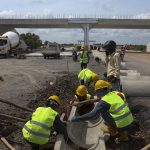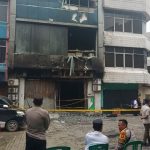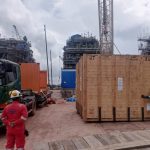Liga Asuransi – Dear readers, how are you? Let’s continue the discussion about risk management and insurance in the construction sector, especially the Construction Erection All Risks and third-party liability or CAR/EAR/TPL Insurance policies.
In the previous few articles, we have discussed CAR / EAR / TPL insurance claims related to the obligation to report accidents that occur as soon as possible, then also your efforts in overcoming and reducing the impact of accidents that occur.
As a senior insurance broker, we want to continue to share our knowledge and experience with you for you to get the maximum benefit from the insurance policy.
Now we will be talking about how to report to the insurance company in case of an accident happen during the project.
This knowledge is important so that the claim process can run smoothly, getting the maximum claim value within a short claim payment time.
If you are interested in this article, please share it with your colleagues so that they also understand like you.
Like our previous article, this time we will also discuss one of the general conditions in the CAR/EAR/TPL insurance policy from Munich Re. Munich Re is the most widely used CAR/EAR/TPL insurance policy format in Indonesia as well as in the world.
By the way, for those of you who are visiting this website for the first time you need to know that here we will discuss various things around risk management and insurance. Please read other articles by clicking on the title at the top, left, and right.
CAR/EAR/TPL insurance policies fall into the engineering risk group. The risks covered by this insurance policy are related to accidents and losses related to construction work, installation, operation of machinery, and mechanical and electrical equipment.
Engineering risks are generally higher than other types of risks such as transportation risks (marine risks), property risks, industrial risks, motor vehicle risks, and others.
Why is a CAR/EAR/TPL insurance policy needed?
Although the advancement of science and the development of technology in the field of engineering is getting higher and higher, all of that has not been able to eliminate risks.
There are still many potential risks for construction projects that can occur. For example, the occurrence of natural disasters such as floods, landslides, earthquakes, tsunamis, and other natural disasters. Although it has been anticipated based on in-depth analysis, accidents still occur.
Likewise other risks such as accidents due to the use of construction tools, design errors, attacks from outside the project, and fires.
Therefore, without CAR/EAR / TPL insurance, once an accident happens, it will be difficult for you to be able to complete the project according to the schedule.
As a result, you need to spend additional funds, the project is delayed as a result of which you are notoriously late fees, and your company suffers losses.
Who needs CAR/TPL insurance?
There are several parties that require CAR/EAR / TPL insurance policy, including project owners, developers, banks, main contractors, sub-contractors, consultants, and suppliers.
To find out the car / EAR / TPL insurance policy coverage, here we want to explain one of the requirements of the policy.
General Condition No. 5d Munich Re
In the event of any occurrence which might give rise to a claim under this Policy, the Insured shall:
- furnishes all such information and documentary evidence as the Insurers may require;
Explanation
After an accident occurs, then you make rescue efforts to prevent more severe damage, then you have notified the insurance company through your insurance broker, then now it’s time to make an official and complete report.
Next, you need to make a white paper claim report and be completed it with the necessary documents and information.
The insurance broker will guide you to prepare all the necessary information. Assist you to complete the relevant documents, make an estimate of the value of the loss, and prepare evidence of the damage caused.
If the estimated claim value is large and above the predetermined value limit, usually the insurance company will appoint a loss adjuster company.
A loss adjuster company is an insurance expert appointed by an insurance company to decide how much money should be paid to someone who makes a claim.
Then the loss adjuster will come to conduct an inspection of the accident site, they have physical data about the incident and have begun to make an estimate of the magnitude of the loss.
In addition to analyzing the physical condition of the damage, they also study the insurance policy documents, to make sure that the accident that occurs is guaranteed or not covered by the insurance company.
Usually, the information from the results of the inspection is not enough, they still need additional information in the form of supporting documents about the basis of ownership, the purchase price, the condition of the goods before the damage, the presence of other interested parties and perhaps if other evidence from the authorities.
If any of the documents are no longer there, you may be able to get copies of them from other parties such as suppliers, financing, banks, and others.
The presence of an insurance broker as an insurance consultant is very necessary for conditions like this. A professional insurance broker will assist and accompany you so that all the information required by the loss adjuster is available.
Documents required for Damage and loss of income claims
For the settlement of damage and loss of property, you are required to submit the following evidence or information:
- Proof of ownership or that you are the party entitled to the claim
- A detailed statement of the claimed amount.
- You receive detailed payments for the necessary repairs or a detailed written estimate of the cost of such repairs.
- A statement stating the date of purchase, purchase price, and residual value for which the improvement is uneconomical
- Offer of replacement and repair costs submitted by the contractor based on damage estimates
- Offers from suppliers for goods and the same type of damaged goods
- Report from the authorities (police) if the loss is caused by theft, robbery and riots
Large Claims Handling
One of the most common reasons why many insurance claim settlements are not smooth, and the results are not optimal is because the documents required by the insurance company are incomplete and inadequate.
The abundance of potential risks – especially because of bad weather to man-made disasters such as terrorism – can result in potentially substantial insurance claims.
Lack of readiness to gather the information necessary to present this claim may cause you to be unable to obtain an insurance claim in the amount as expected.
Many insureds do not get what they are entitled to from their insurance claims and one of the reasons is that they underestimate insurance requests to supplement information and documents.
So, it is important that you pay attention to how to respond to insurance requests to provide more detailed information when filing a claim. It’s quite simple, that is, you need to be able to explain and make sure that they understand how the claim process works and prepare for it.
For large claims, you must maintain credibility with the insurance market. They have a contractual responsibility to provide information as a term and condition of running from the insurance policy.
Forensic survey
For large claims, the insurance company and loss adjuster will also take advantage of forensic facilities whose results are much more thorough than the usual loss evaluation process. They also don’t hesitate to bring a complete forensic tool and they can also appoint forensic accountants, lawyers, and other industry experts in the first place.
According to the principle of insurance, the responsibility lies with the policyholder to prove their claim, usually, they are required to provide books and other business books, vouchers, invoices, balance sheets and other documents, evidence, information, explanations, and other evidence that the Insurer can request for the purpose of investigating or verifying the claim, necessary, a legal statement about the correctness of the claim and matters relating to it.
In short, insurance companies want to prove every element of the claim, going through detailed documentary evidence of timesheets, daily rates, and purchase orders.
If the insured is unable to provide the details requested by the insurance and it can be considered as one negligence, the consequences are great. If an insurance claim is presented with insufficient documentary evidence, most insurance companies will apply a large discount or withhold the value of the claim in large amounts.
Time Challenge
Compiling a report for a large insurance claim can be a tension between the company’s important priorities to struggle back to the operation or to quickly recover from losses.
On the other hand, it is required to collect and prepare information for the insurance company after a large loss. Spend a lot of time and resources – when resources are focused on efforts to restore business operations and retain customers.
It is during conditions like this that the insurance broker can provide the maximum role. If you want to optimize the recovery of losses, then you must get as much evidence as possible.
Equally important is to check every document and information that exists to ensure that commercial, sensitive, or unnecessary information should not go unnoticed. The insured should question whether the requested is part of the ‘shopping list’ of documents needed to prove the loss, or something unrelated to the claim.
Preparation
Appointing the personalities to be involved in the insurance claim is very important. The appointee can be responsible for the claim and must know where and from whom the person contacted to access important information and what resources they need to help them deal with the claim effectively.
After that, the Loss adjuster will immediately calculate and determine the amount of potential loss, using the basis of estimating the length of the claim process. From then on, a lot of information is needed to support the claim and evidence of the loss.
A clear communication strategy is essential
All information must be funneled through a senior person before it is submitted to the insurer, this is important in avoiding unnecessary duplication or inaccuracies, which can slow down or hinder the claim process.
To deal with large claims you should take into consideration the following:
- Resources – who will you need them, and how do you access them?
- Do you need specialists, and external claims preparation support?
- Appoint a team of big losses with the responsibility to make decisions – who will be responsible?
- Immediate response – who does what?
- Loss mitigation plan
- Information – Where does your organization store the data you need to prove claims? who, what, how are you going to record and capture it?
- Quantification and loss preparation – what’s the process?
- Communication and reporting – stakeholders, internal management, and external parties
- Who is your insurance broker?
- If you don’t use an insurance broker, who is the legal advisor who is an expert in the field of insurance claims
Presentation of Reports
Having the right evidence to explain and justify your claim is very important. If you can’t explain it, the loss adjuster parties can draw their own conclusions, which may not be accurate.
Make sure you gather the correct information from the start and structure it in one place, with a good explanation of how much it will cost and why it is needed – it is very difficult to do this retrospectively if you have not done it while walking.
The quality of the information and data presented to the loss adjuster is the key to optimizing the recovery of insured losses. In the end, if you want to pursue a successful claim, the responsibility lies with you.
Why for CAR / EAR / TPL insurance you always need to use the services of an Insurance Broker?
From the explanation above, it is not easy to take care of insurance claims, especially if the claims that occur are of great value.
Taking care of a CAR / EAR / TPL insurance policy is not easy because of the high risk. Not many insurance companies are willing to provide guarantees.
In addition, it requires extensive insurance knowledge and experience in engineering insurance and knowledge of engineering risks so that insurance coverage is maximized.
The best way to get CAR/EAR/TPL insurance is to always use the services of an authorized insurance brokerage company registered with the Financial Services Authority (OJK).
Insurance brokers design insurance programs that best suit your project’s risk conditions. Find an insurance company that can cover risks such as your project at competitive premium rates.
An important benefit of using the services of an insurance broker company is that you will get help in resolving claims for free. The insurance broker also acts as your advocate for the settlement of insurance claims.
One of the insurance brokers companies in Indonesia with extensive experience in the field of construction insurance is L&G Insurance Broker.
For all your project insurance needs contact L&G now!
Source:
- https://www.law.cornell.edu/cfr/text/29/15.105
- https://www.echelonccl.com/our-insights/claims-guidance/providing-the-right-evidence-when-making-a-claim.html
—
Looking for Insurance Products? Don’t Waste Your Time and Contact Us Right Now
L&G HOTLINE 24 HOURS: 0811-8507-773 (Call – Whatsapp – SMS)
website: lngrisk.co.id
E-mail: customer.support@lngrisk.co.id
—

















